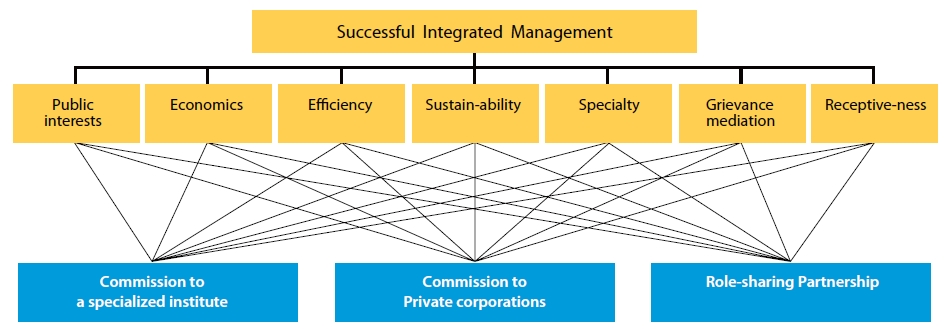



The AHP is a systematic analysis technique developed for multi-criteria decisions [4]. Its operating mode lays on the decomposition and structuring of a complex issue into several levels, rigorous definition of manager priorities and computation of weights associated with the alternatives. The output of the AHP is a ranking that indicates the overall preference for each decision alternative.
The AHP technique involves quantitative and qualitative feature in a unique analysis structure that converts the natural thoughts of any human being into an explicit process. The latter is implemented in a decision-support tool that provides objective and reliable results, even under different scenarios.
Assuming that
[Table 1.] Value scale for alternative decision comparisons [4]
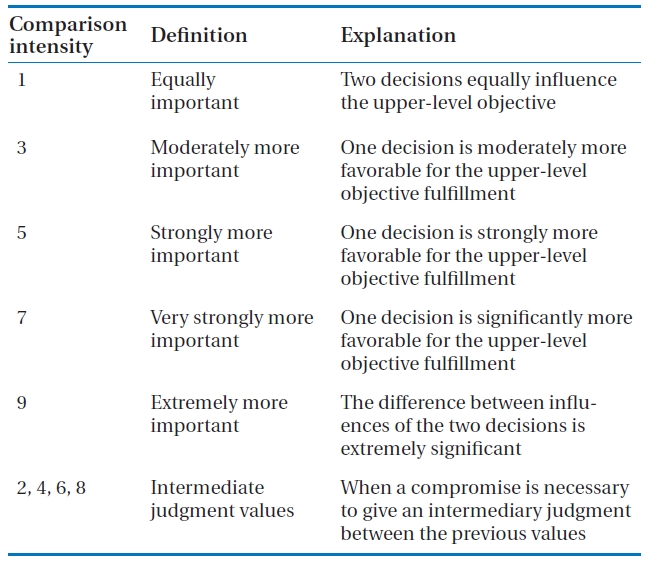
Value scale for alternative decision comparisons [4]
The method supposes that only the first column of matrix A is required to state the relative importance of factors 2, 3, . . . ,
Eq. (1) shows that multiplying the matrix by the vector of weights
Therefore, to recover the overall scale from the matrix of ratios, the Eigenvector method was adopted [4]. According to the previous equation, the problem can be formulated as
Thus, the scale can be recovered from the comparison matrix. In this exact case, the solution was any normalized column of
However, in actual cases, precise values of
The solution to the problem of the largest Eigenvalue, which is the weight Eigenvector, w, corresponding to λmax when normalized, gives a unique estimate of the underlying ratio scale between the elements in the studied case. Furthermore, the matrix whose entries are
The CI of the studied problem is compared with the average random index (RI) obtained from associated random matrices of order
3. Hierarchical Scheme for AHP
As shown in Fig. 1, a hierarchical scheme for the AHP [4] was designed to achieve successful utilization of the IMS for sewerage facilities in the upper reaches of multi-dams using an AHP. Three alternatives were selected to decide who should control the IMS for sewerage facilities:
Alternative 1: commission to a specialized institute, i.e. public corporations, such as the EMC. The association of related local governments still plays a role as a regulator. This alternative secures specialty, and derives independent and responsible management.
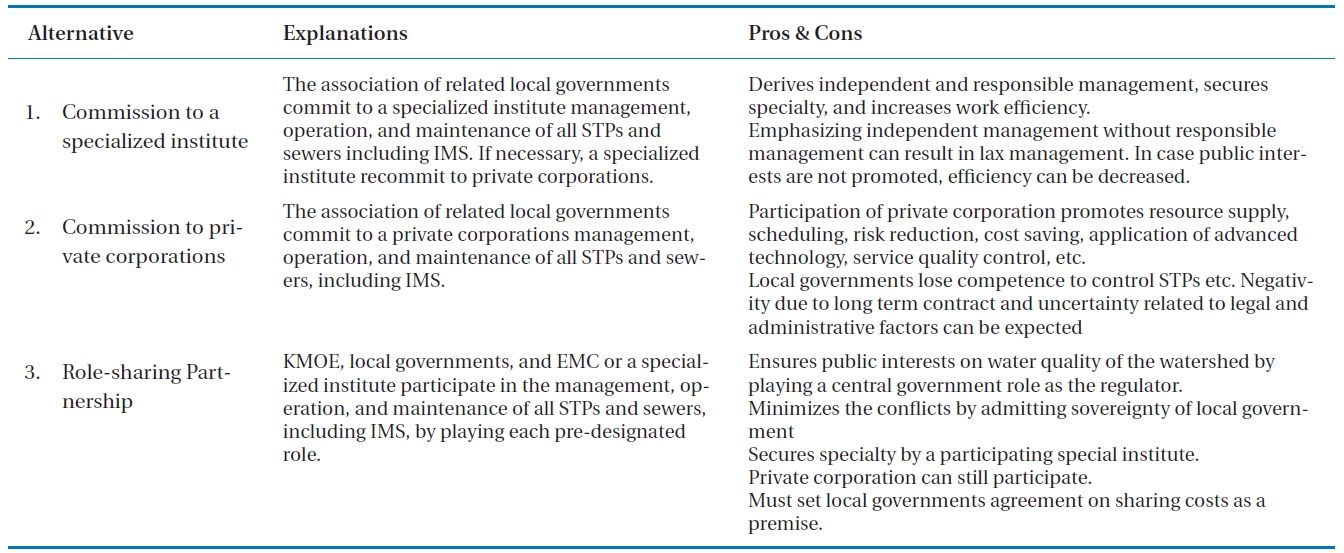
Pros and Cons on the three alternatives for deciding who should control the IMS for sewerage facilities
[Table 3.] Description of each factor influencing the IMS for sewerage facilities

Description of each factor influencing the IMS for sewerage facilities
Alternative 2: commission to private corporations. This alternative promotes cost saving, application of advanced technology, and service quality control, etc.
Alternative 3: role-sharing partnership, which suggests that KMOE, local government, and a specialized institute, such as the EMC, share the role of managing, operating and maintaining the IMS for sewerage facilities. Table 2 shows the pros and cons when each alternative is implemented.
[Table 4.] Comparison matrix for each factor (an illustration answered by a respondent)
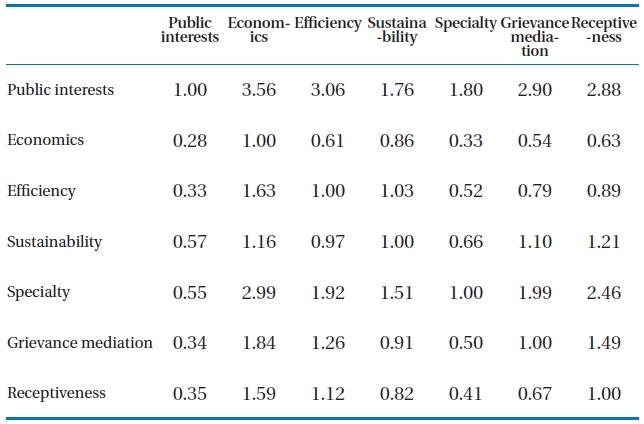
Comparison matrix for each factor (an illustration answered by a respondent)
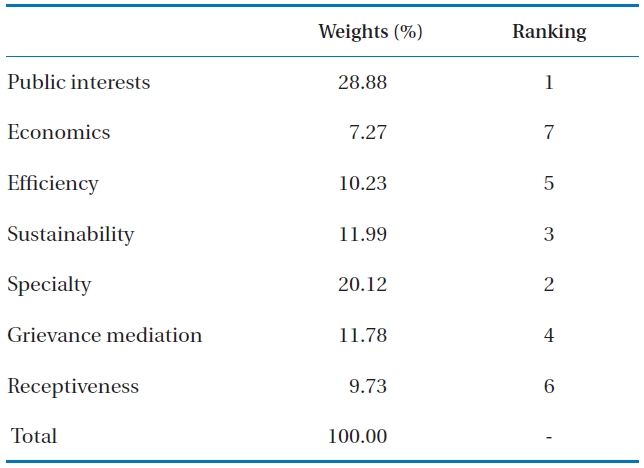
Weights and ranks of each factor for a successful integrated management of sewerage system
[Table 6.] Evaluated results for each factor and each alternative (%)
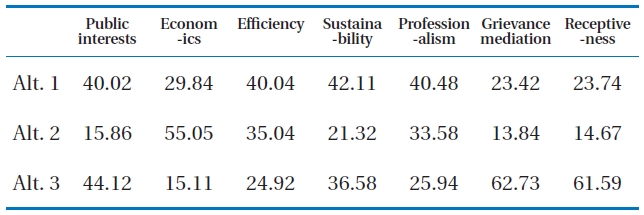
Evaluated results for each factor and each alternative (%)
[Table 7.] Final scores and ranks of the three alternatives
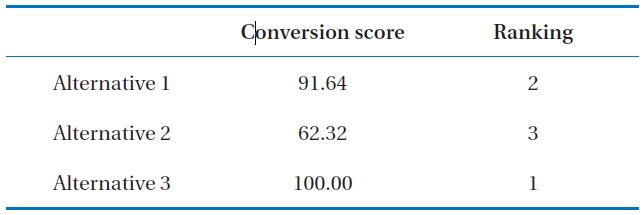
Final scores and ranks of the three alternatives
The seven factors influencing the decision as to who should control the IMS, as well as achieving the goal of successful utilization of IMS, were selected via a brainstorming conference. Table 3 shows the descriptions of the seven factors.
A questionnaire, composed of pairwise comparisons, was prepared based on the predetermined hierarchical scheme and sent to experts (engineering consultants, operators of STPs, and university professors) engaged in the field of sewerage design and construction. In this study, 31 different individuals provided independent comparison values. The comparison framework, as outlined above, was carefully explained to each evaluator, who was then asked to quantify accordingly the comparison values for all factors and alternatives.
Tables 2 and 3 were used to provide a common basis for the comparisons, although each evaluator was free to make their own decision regarding the consequences. A typical comparison matrix is shown in Table 4.
After receiving 31 answers, the analysis was performed using MS-Excel, with the rates of inconsistency for each factor evaluated. The CI was calculated as 0.01, whereby the ratio CI/RI = 0.014/1.320 = 0.011<0.1. In all cases, the evaluators stayed within this constraint; thus, the consistency level regarding the weights was satisfactory.
Table 5 shows the calculated weights and ranks of each factor. Public interest received the highest weight; whereas, receptiveness received the lowest weight for successful IMS of sewerage system.
The evaluated results for each factor and each alternative are shown in Table 6. Commissioning to a special institute (Alternative 1) received the highest score for sustainability, but the lowest for grievance mediation. Commissioning to a private corporation (Alternative 2) received the highest score for economics, but the lowest for grievance mediation. The role-sharing partnership (Alternative 3) received the highest score for grievance mediation, but the lowest for economics.
Table 7 shows the final scores and ranks for the three alternatives. As a final result, the role-sharing partnership (Alternative 3) received the highest score (conversed score of 100). Although commissioning to a special institute (Alternative 1) received the medium score, the difference in the scores between alternatives 1 and 3 was very slight. Thus, alternative 1 cannot be overlooked as a possibility without careful consideration. It was notice that the complete commissioning to a private corporation showed a significantly lower preference than the other alternatives.
In this study, an attempt was been made to compare different entity alternatives for the successful implementation of the management, operation and maintenance of the IMS for sewerage facilities in the upper reaches of multi-purpose dams in Korea. Three alternatives were considered in deciding who should control the IMS for sewerage facilities: commissioning to public corporations, commissioning to private corporations, or a role-sharing partnership. In using the AHP technique, the emphasis was on comparing public interests, economics, efficiency, sustainability, specialty, grievance mediation and receptiveness.
The role-sharing partnership (Alternative 3) received the highest score (conversed score of 100). Although commissioning to a special institute (Alternative 1) received the second highest score of the three alternatives, the difference in the scores between alternatives 1 and 3 was not significant. Thus, alternative 1 cannot be easily dismissed as a method without careful consideration. These results lead us to the conclusion that decision-makers can choose either alternative 1 or 3.
This research was supported by a Chung-Ang University ResearchGrants in 2005-2006.
![Value scale for alternative decision comparisons [4]](http://oak.go.kr/repository/journal/10079/E1HGBK_2010_v15n2_99_t001.jpg)
